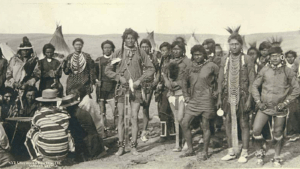What’s with all the begats? Do you skip over the genealogies when you read through the Bible? If so, you’re not alone. These long lists of names, usually joined by the famous “begat” in the King James Version or “became the father of” in other translations, often seem like tedious interruptions to otherwise riveting stories.
But genealogies do not simply list names for the sake of providing an historical record. Lurking behind all those “begats” are multiple literary, social, and political functions that enable genealogies to tell their own stories.
Genealogies organize narratives. Particularly in the book of Genesis, the genealogical formula “these are the descendants of…” (Hebrew toledot) marks transitions between sets of stories. For example, at Genesis 36:1, immediately after recounting the many adventures of JacobThe son of Isaac and Rebekah, renamed Israel, became the father of the twelve tribal families. More and the death of IsaacSon born to Abraham and Sarah in fulfillment of God's promise. More, the narrative reports, “These are the descendants of Esau…” A lengthy genealogyGenealogy involves the study and tracing of families through the generations—in short, family history. One genealogy in Genesis traces the nations descended from Noah. In the New Testament Matthew traces the ancestry of Jesus back to Abraham, while Jesus' genealogy in the Gospel of Luke... More follows, and then the narrative moves back to the line of Jacob and the Joseph story.
While the inclusion of genealogies among family stories might be expected, more surprising is the use of the same genealogical formula between the two accounts of creationCreation, in biblical terms, is the universe as we know or perceive it. Genesis says that in the beginning God created the heavens and the earth. In the book of Revelation (which speaks of end times) the author declares that God created all things and... More in Genesis 1 and 2: “These are the generations of the heavens and the earth when they were created” (Genesis 2:4a). Thus, the idea of “generations” helps organize the narratives into sections, even when family histories are not specifically involved.
Genealogies make claims about social roles. The idea of monarchic succession is familiar: kings and queens must be able to prove their bloodline to demonstrate a rightful claim to the throne. Yet genealogies can also prescribe or justify other positions, especially in a society organized by kinship. The nine chapters of genealogical material that open the book of 1 Chronicles give particular attention to jobs assigned to Levitical families: for example, musicians are appointed from each of the families of Korah, Gershom, and Merari for service in the sanctuaryA sanctuary is the consecrated area around the altar of a church or temple. It also means a place of safety where one can flee for protection. In the Old Testament, especially in the Psalms, God is referred to as a sanctuary, a refuge from... More (1 Chronicles 6:31-48).
Genealogies establish boundaries between insiders and outsiders. The destruction of the Jerusalem templeThe Jerusalem temple, unlike the tabernacle, was a permanent structure, although (like the tabernacle) it was a place of worship and religious activity. On one occasion Jesus felt such activity was unacceptable and, as reported in all four Gospels, drove from the temple those engaged... More and the exile of the city’s elites to Babylon in 586 B.C.E. disrupted recognized social and religious patterns. When exiles began to return to JudahJudah was the name of Jacob's fourth son and one of the 12 tribes. More from Babylon, the community had to reorient itself to a new reality, which included negotiating competing claims about who and what were required for proper worship. NehemiahThe governor of Jerusalem who rebuilt the city walls after the exile. More enrolls the returnees according to their genealogies, thus establishing who “rightfully” belongs in the community. When some of the returnees claim priestly descent but cannot find their names in the genealogical record, they are excluded from priestly roles (Nehemiah 7:61-65).
Genealogies tell a story. All of the functions described above — literary, social, and political — come together to tell a particular story about a person or family. Perhaps the most compelling biblical genealogy for Christian readers is the genealogy of JesusJesus is the Messiah whose life, death, and resurrection are God's saving act for humanity. More offered by the Gospel of MatthewA tax collector who became one of Jesus' 12 disciples. More (Matthew 1:1-17).
Matthew’s genealogy of Jesus aligns neither with Luke’s (Luke 3:23-38) nor with Old Testament evidence, pointing to purposes beyond historical record-keeping. Situated at the beginning of the Gospel, the genealogy is, like the genealogies in Genesis, an introduction to a new narrative block. Thus, it fulfills a basic literary purpose while also following an Old Testament precedent. Matthew’s genealogy also situates Jesus within the ongoing story of the people of Israel as a whole. By connecting Jesus to AbrahamGod promised that Abraham would become the father of a great nation, receive a land, and bring blessing to all nations. More, Matthew emphasizes that Jesus is indeed a Jew, an “insider” descended from the patriarch whom God promised to “make of you a great nation” (Genesis 12:2). At the same time, the prominence of King DavidSecond king of Israel, David united the northern and southern kingdoms. More in the genealogy credentials Jesus for the social role of kingship, to be the messiahThe Messiah was the one who, it was believed, would come to free the people of Israel from bondage and exile. In Jewish thought the Messiah is the anticipated one who will come, as prophesied by Isaiah. In Christian thought Jesus of Nazareth is identified... More (that is, one anointed, as ancient Israelite kings were).
At the same time, Matthew’s genealogy attends to the personal side of Jesus’ background. Although biblical genealogies only rarely name women, Matthew takes special care to highlight four female ancestors of Jesus, in addition to his mother Mary: Tamar (verse 3), RahabWoman who sheltered Joshua's men when they came to spy on Jericho. More (verse 5), RuthThe great-grandmother of David. More (verse 5), and the wife of UriahOne of King David's military heroes and the husband of Bathsheba. More (i.e., BathshebaWife of David and mother of Solomon. More, verse 7). Each of these women is both scandalous and heroic in her own way. Tamar conceived Perez and Zerah with Judah, her father-in-law, by posing as a prostitute when Judah’s sons would not fulfill their levirate marriageLevirate marriage is a marriage in which a childless widow marries her husband's brother in order to continue the line of her dead husband. Ruth is married to Boaz in a Levirate-like marriage (actually a kinsman marriage). This Mosaic law is at the heart of... More obligations (Genesis 38). Rahab, a Canaanite by ethnicity and a prostitute by trade, saved the lives of two Israelite spies (Joshua 2). Ruth, a Moabite woman, sought justice for herself and her mother-in-law NaomiThe mother-in-law of Ruth. More by seducing BoazHusband of Ruth and great-grandfather of David. More. The wife of Uriah was the object of the sexual advances of King David, who arranged for Uriah’s death in battle in order to legitimate his own relationship with Uriah’s wife. All four women were outsiders by gender, most by ethnicity and, to different extents, reputation. Even Mary, the mother of Jesus, was an unwed mother, a scandal that nearly caused Joseph to break their engagement (Matthew 1:19).
The presence of these women in the genealogy foreshadows Jesus’ radical embrace of the outsider. At the same time, Jesus has the pedigree of an insider, the lineage of a king, and that lineage would not have survived without the extraordinary interventions of these women. Matthew’s genealogy of Jesus, simply by constructing a list of names, already tells the story of a radical new messiah who nonetheless stands in continuity with the tradition that has gone before.
So, what’s with all the begats? Within every genealogy is a story, a claim of identity, an answer to the question, “Who are you?” The next time you encounter a genealogy in the Bible, dwell on it awhile. You may find a new story lurking behind those names.








